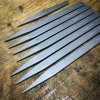- Joined
- Jan 9, 2014
- Messages
- 527
Anyone have experience removing cnc milling marks using a tumbler? My research so far hasn't turned up a whole lot; so I thought I'd consult some of the knowledgeable people on this forum!
When our blades come off the mill we have to do a lot of buffing (starting with fairly aggressive compounds) to remove the machining marks and it is quite tricky to do it evenly without taking the lateral CNC lines out (we leave the lines as a signature look). I've been doing a lot of research on tumblers and have found that most people finish up to 400 grit or so before tumbling; because we aren't grinding the knives that is not really a possibility. What I'm looking for is a way to remove or at least blend in the machining marks and get a consistent finish. After buffing there are still some light marks but they aren't very noticeable. My questions are as follows:
1. Is there a type of media that is aggressive enough to remove these type of milling marks and small enough get in to all the nooks (the corners of each step where there is a bit of a sheltered area)?
2. If such a media does exist, would it abrade fairly evenly or would it affect the high points at a higher rate than the nooks and corners?
3. Are the lateral milling lines (the ones we want to keep) likely to be eroded away in the process?
Below left is a photo of one of our fillet knives as it comes off the mill and on the right is a blade after buffing. Sorry for the bad photos.


Any insight from all you makers would be greatly appreciated!
thanks,
mike
When our blades come off the mill we have to do a lot of buffing (starting with fairly aggressive compounds) to remove the machining marks and it is quite tricky to do it evenly without taking the lateral CNC lines out (we leave the lines as a signature look). I've been doing a lot of research on tumblers and have found that most people finish up to 400 grit or so before tumbling; because we aren't grinding the knives that is not really a possibility. What I'm looking for is a way to remove or at least blend in the machining marks and get a consistent finish. After buffing there are still some light marks but they aren't very noticeable. My questions are as follows:
1. Is there a type of media that is aggressive enough to remove these type of milling marks and small enough get in to all the nooks (the corners of each step where there is a bit of a sheltered area)?
2. If such a media does exist, would it abrade fairly evenly or would it affect the high points at a higher rate than the nooks and corners?
3. Are the lateral milling lines (the ones we want to keep) likely to be eroded away in the process?
Below left is a photo of one of our fillet knives as it comes off the mill and on the right is a blade after buffing. Sorry for the bad photos.


Any insight from all you makers would be greatly appreciated!
thanks,
mike


